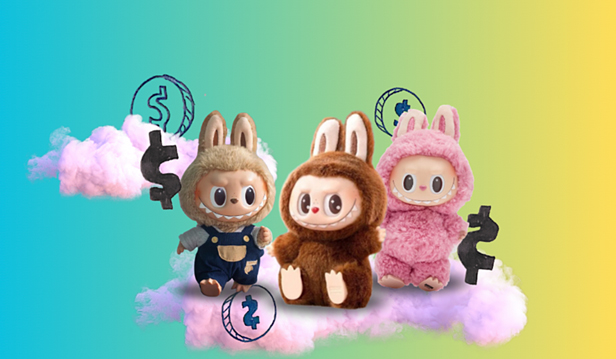Strategy July 07, 2025
Labubu-nomics & the Blind Box Boom: How the Viral Trend Could Be a Promo Opportunity
The mystery box concept comes with an element of rarity and surprise that keeps customers wanting more.
Key Takeaways
• Blind Box Boom: Pop Mart has seen a surge in popularity and revenue due to the viral success of its Labubu dolls, which are sold in mystery blind boxes and have become status symbols and collectibles.
• Psychology Play: The appeal of blind boxes lies in variable ratio reinforcement – a psychological reward system similar to gambling – which keeps consumers engaged and drives repeat purchases.
• Promo Potential: Distributors like Dryvve (asi/154912) are exploring blind box-style promotional products as a strategic marketing tool to boost engagement, storytelling and brand visibility.
Savannah Dmytriw is someone who doesn’t like to waste time.
So when she decided she wanted a Labubu – Pop Mart’s colorful, elfish dolls sold in blind boxes – she didn’t keep trying her luck until she got the one she wanted. Instead, she bought the pink lychee Labubu off resell site StockX for $80.

The dolls have resulted in a surge in demand for Pop Mart – their parent company. (Photo illustration by Olivia Borgula)
“It’s not just a plush, it’s a status symbol,” the vice president of marketing at Team SCG (asi/315978) says.
Labubus swarmed social media this year as the most recent craze in a blind box boom – an emerging opportunity for promo as companies start capitalizing on the hype for mystery boxes.
The toothy, devilish dolls adorn bookshelves, dangle off car mirrors and hang on belt loops as fashion accessories. They typically retail for around $30 in the U.S., but they’re constantly sold out online and in stores, so scalpers can sell them and off-brand “Lafufus” for much higher, even up to hundreds of thousands of dollars.
The Nordic-inspired figurines are sold in opaque surprise boxes; customers don’t know what they’re getting until they open the packaging. This element of rarity has driven thousands of unboxing videos, where users reveal the doll on camera and commenters react with their own frustrations or experiences. They’ve even made their way onto the bags of celebrities like Rihanna, Dua Lipa and White Lotus and K-pop star Lisa from Blackpink.
“There’s no doubt that adding mystery to a product makes it more desirable,” says James Whelan, a professor at the University of Memphis who studies gambling.
The popularity has led to a spike in business for Pop Mart. Last year, the company more than doubled its revenue from 2023 and was consistently the top-traded brand on StockX. About 22% of Pop Mart’s total revenue in 2024 was from plush toys, according to its annual financial report.
Shari Hoffman, marketing director at Dryvve (asi/154912), didn’t know what Labubus were until her friend got one. But now she sees them everywhere.
“I hopped on TikTok, and I went to Instagram, and I’m like, ‘Oh my gosh, these things are crazy blowing up,’” she says. “What is this phenomenon? Why are we so upset over this weird looking toy, and how can we make it work for us in the marketing world?”
The Blind Box Concept
While Labubus are currently soaking in virality, they’re not what originally popularized the blind box concept. Products that follow a similar mystery box pattern like Sonny Angel, Smiski and Skullpanda figurines have grown steady communities for years.
In fact, the very first blind boxes can be traced back to fukubukuro, or “lucky bags,” sold by Japanese retailers in the early 20th century. Gachapon – Japanese vending machines that dispense toys in plastic capsules – were popularized in the 1960s and are another precursor to the mystery toy concept.
While many popular blind box collections originate in countries like Japan and China, they’ve quickly proliferated in the U.S. market, largely driven by companies like Pop Mart. The Chinese company opened its first permanent U.S. store in 2023, but as of June, it’s grown to 22 stores scattered across the country and expects to double its locations by the end of the year.
As a promo product, blind boxes can be more costly to produce and market than standard items, but they’re intrinsically more alluring to customers because of human reward systems. There’s a feeling of gratification from opening the box, just to see what’s inside, even if the result is negative. It feeds the cycle of anticipation and reward with a rush of dopamine.
Jeremiah Weinstock, gambling expert and chair of the psychology department at Saint Louis University, says blind boxes work because of variable ratio reinforcement – you don’t know when you’ll get the reward and when you do, it’s highly rewarding.
Research shows this type of reward system is the best way to keep someone engaged in activity, or the best way to keep customers buying, he says.
“We’ve become very good at understanding people’s brain chemistry and how to utilize that in selling products,” Weinstock says. “It’s just monetizing our brain chemistry.”
Opportunities for Promotional Products
Brands have already capitalized on this trend by fitting merch into the mystery surprise concept. Duolingo sells blind boxes with seven variations of its signature owl mascot, and brands like Star Wars, Disney and Lego have created their own blind boxes with toys based on their unique characters.
Blind boxes, by nature, encourage sharing. The first thing you want to do after opening them is tell people what you got. That, paired with their element of rarity, keeps customers buying in hopes of completing the collection.
Companies could create employee recognition rewards with a series of different company mascot figurines or pins with different values on them, Hoffman says. At trade shows, blind box promo could drive foot traffic and encourage people to stay by rewarding them with a mystery box if they scan a QR code or attend a demo.
“Blind boxes and collectible promos are an untapped gold mine when you use them strategically,” Hoffman says. “You’re leveraging storytelling around each item. … You’re using these revealing moments to drive anticipation and retention.”
Dmytriw says another reason Labubus are so popular is because they’re at the intersection of the blind box and plush trend recently popularized by companies like Jellycat. They’re also sold as keychains, which Dmytriw says are increasingly sought after by Gen Zers and younger consumers.
In an era where people can order anything they’re craving straight to their doors or ship specific items overnight, the idea of not knowing what you bought is enticing, Dmytriw adds. She says she’s already started turning the Labubu blind box concept into a pitchable idea.
“The biggest indicator that something is going to be successful is that people aren’t indifferent about it,” she says. “There is a world that this could definitely be done, and I’m excited to continue to explore it.”
